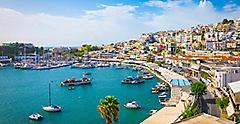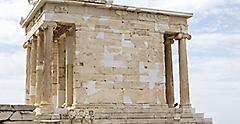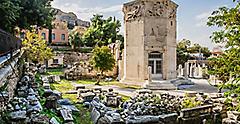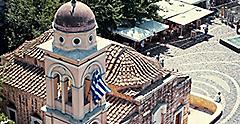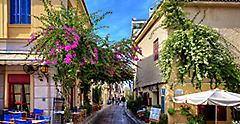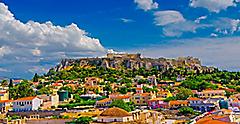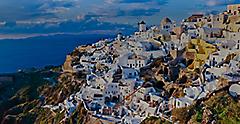Best Things To Do In Athens, Greece, On Your Cruise Vacation
Make the Most of Athens
By Claire Heginbotham | Published on July 19, 2023
The history, cultural artifacts, and language of Athens, Greece, transport you back to a time when gods roamed the earth, the wine flowed and casual conversation leaned toward philosophy, mathematics and art.
There is no shortage of things to do in Athens on a Greece vacation. The Greek capital has a history of more than 3,400 years to entertain you. Once home to Plato, the "father of Western philosophy," the birthplace of the first democracy, and the first higher education institution in the West, Athens never ceases to impress. The striking mix of marbled buildings built centuries ago and the bustling modern city makes Athens a place where the old doesn't just meet the new — it crashes together in one giant melting pot of history and culture.
Explore The Largest Port In Greece
Part of the Saronic Gulf, the cruise port of Piraeus was the main port of Athens and one of the oldest ports of ancient times. It was built when the city of Piraeus was founded in the early fifth century B.C. and is now one of the largest ports in Europe. This is your gateway to Athens' most popular attractions and its surrounding islands.
You might think that the only things you will find in Piraeus cruise port are the terminal buildings and travelers; in reality, Piraeus is a bustling city with plenty to explore. When I arrived, I ensured I was wearing my comfiest walking shoes and set out to discover what hidden gems the port had to offer. Here's my recommended itinerary for exploring the port:
First up, wander over to the Archaeological Museum of Piraeus, which has artifacts that date back thousands of years to the beginning of a distinctive Greek culture.
Next door to this museum is the impressive ruins of the Ancient Theatre of Zea, which were excavated almost 200 years ago. It's humbling to realize that 19th-century archeologists found these ruins!
Not too far away is another museum I highly recommend if you're interested in anything ocean-related, the Hellenic Maritime Museum. Its wall is home to an engaging collection of books, maps, flags and weaponry.
Lastly, if you're on your way back to your cruise ship, stop at Mandragoras Spice Market — a locally owned collection of shops overflowing with spices and traditional Greek foodie delights.
A quick tip: If you want to follow this route, consider taking a 90-minute walking tour from cruise port Terminal A. Once finished, it's a short walk to the metro. Catch the free shuttle buses to the train station to explore the port after the city. The trip from Athens to Piraeus' port takes around 45 minutes.
Dive Deep Into The History Of Greece
As a frequent traveler, I find that nothing has the gravitas of a temple. Athens contains three of the most important temples in Greece and, luckily for busy cruise travelers, they're all on one hill: the Acropolis.
To visit the Acropolis, you must purchase a ticket online or in person, or go with a tour guide. I recommend buying your ticket online, entering at the side gate, and visiting in the early morning or late afternoon to avoid crowds. You can easily spend hours here looking over the city, but most groups plan for two to three hours to see all three temples and the surrounding area.
Perhaps the most underrated temple, the Temple of Athena Nike is dedicated to the worship of Athena and the goddess of victory, Nike, who was worshiped here in times of war. This is the smallest temple on the Acropolis hill and lies next to the impressive Propylaea gateway. This little temple is unique in many ways compared to its neighbors. Most notable is the smaller ratio of the column size to the building. Modern architects theorize the larger columns were designed to keep harmony with the giant columns of the Propylaea gateway. Visiting this temple requires a bit of a climb but is worth it once you get to the top.
The Greek origin of the word Agora means "to congregate," and there were two places in the city center that were dedicated hot spots for public speaking, administration and commerce: Ancient Agora and Roman Agora.
Ancient Agora of Athens is mostly an archeological site today, but your first visit is not just about the views. It's about standing on the same ground as Sophocles, Socrates, Protagoras and other great philosophers and politicians. Here, governance and culture were discussed, argued and improved. I highly recommend walking on to the Temple of Hephaestus, one of the best-preserved temples in Greece.
Venture Into The City Of Athens
On an Athens vacation, history and culture are the main draw. That said, there's so much to do beyond that on day trips from Athens. Athens is pleasant all year round, and if you visit Athens in the summer as I did, you can expect some seriously high temperatures in the 90-degree zone, so be prepared to wear loose and breezy clothes. That said, you may need to take a break from sightseeing in the heat to pop into some shops and cafes.
You don't even need to enjoy shopping to enjoy the many marketplaces of Athens — there's a beautiful variety of street food, coffee shops and casual luncheons. Head to these vibing marketplaces for a few hours of indulgence, sipping on ouzo (a potent liquor fondly referred to as "mother's milk" by Greeks), enjoying the best tzatziki, olives, and wines you've ever tasted, and browsing all kinds of souvenirs.
Stay In Athens For A Few Days
In a packed port-of-call itinerary, you have to be a master of logistics! Athens day trips deserve a few days of your time, so it's best to stay in Athens before or after your cruise to get the full experience. With a few extra days, you can see more of the National Archaeological Museum. Of more than 11,000 exhibits, only five collections are permanent. This is a great place to escape the summer heat and spend a few hours soaking up the enormously rich history of Greece.
Get Royal Deals, Sign Up Today
Related Articles

Family Cruise Activities on Ovation of the Seas
READ MORE

10 Galveston Camping Tips | Royal Caribbean Cruises
READ MORE
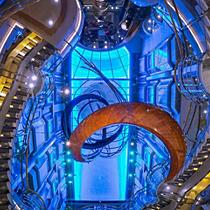
Free Things To Do Onboard Explorer of the Seas
READ MORE

What Is Oktoberfest in Germany? What To Know Before You Go
READ MORE

